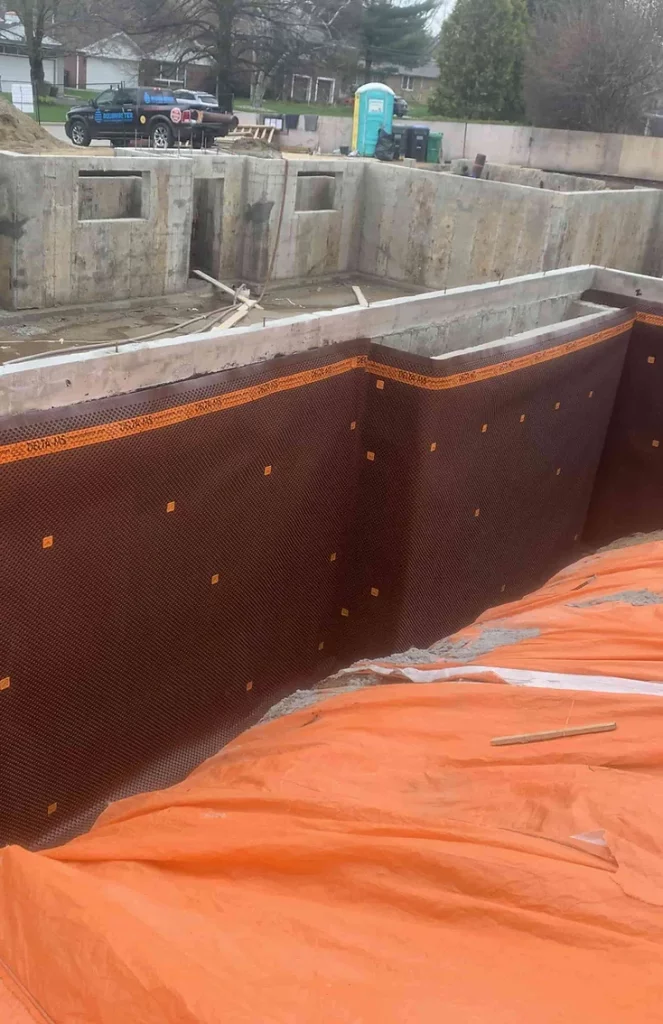Exterior Basement Waterproofing Toronto
Exterior Waterproofing
for Your Property!
Welcome to Aquamaster, your expert exterior waterproofing company in Toronto & Ontario. Since 2009 we helped thousands of properties prevent & repair basement water leaks.
Book your FREE on-site estimate to learn how basement waterproofing can help protect your property!

Definition
What is Exterior Basement Waterproofing?
Exterior waterproofing refers to the process of preventing water from entering the foundation or basement walls of a building from the outside. It is a method used to protect the structure from water damage, such as leaks, dampness, and mold growth. Unlike interior waterproofing, waterproofing the basement from the outside is considered a permanent solution that actually prevents water from entering your basement, as opposed to managing the water that has already made it through.

Why Waterproof Your Property from Outside?
Benefits of Exterior Waterproofing Toronto
A dry & healthy basement is something that every household wants. The heavy rainfall, snow melts and high humidity can create unwanted risks to the cozy basement space. This can pose risks especially if your basement is finished – water leaks can damage not only the foundation but also the drywall, floor coverings, and more.
In cases like this, you will likely see wet or damp basement floors, wet wall stains, mold growth or a musty smell. In case you do, it’s very important to act ASAP. Wet basement problems don’t fix themselves. In fact, they only tend to get worse over time.
While there are a lot of different approaches to wet basement repairs, exterior waterproofing is considered to be the most effective solution.
This is because waterproofing your basement from the outside will involve installing a waterproofing membrane – a barrier that will minimize the interaction your foundation has with the groundwater. The result – is minimum water makes it to your basement (or if done properly – no water at all).
Here is What your Exterior Waterproofing Project May Look Like
Exterior Basement Waterproofing Process
Exterior waterproofing process by Aquamaster involves top quality materials & workmanship to ensure the waterproofing is done right and lasts for a long time. In order to achieve a quality and lasting solution, our team will make sure your foundation is sealed with the waterproof coating from the outside. In a nutshell, this typically involves excavating around the foundation, claning and drying the foundation walls. Our team will then repair any of the newly discovered wall cracks and begin the waterproofing process. Here is more details of the process.
Assessment
A professional waterproofing contractor assesses the building to determine the extent of water infiltration, the condition of the foundation walls, and any other potential vulnerabilities. Our team will perform a visual inspection, may also conduct tests, and analyze the drainage patterns around the building.
Excavation
The area around the foundation is excavated to expose the exterior walls. This is typically done using heavy machinery such as excavators or backhoes. However, in cases when that is not much space evailable we may need to do the diffing manually. The depth of the excavation depends on the specific requirements of the project.
Wall Preparation
Once the walls are exposed, they are thoroughly cleaned to remove dirt, debris, and any loose or deteriorated material. The contractor may use power washing, wire brushes, or other appropriate methods to ensure a clean surface.
Wall Repairs
Next, we will need to fix wall cracks. Any cracks, gaps, or damaged areas in the foundation walls will be repaired. This can involve filling cracks with hydraulic cement, epoxy injections for structural cracks, and patching damaged sections. The goal is to create a solid and seamless surface. Many of these cracks are not visible from the inside, so it’s good that we caught them early on.
Waterproofing Membrane Application
A waterproofing membrane is applied to the exterior walls. The type of membrane used may vary, but common options include asphalt-based membranes, rubberized asphalt membranes, or polymer-based coatings. The membrane is typically applied in multiple layers to ensure effectiveness.
Drainage System Installation
A drainage system (weeping tile aka French drains) is installed around the foundation to redirect water away from the building. This includes components such as drain tiles, gravel, and perforated pipes. The system collects water that may accumulate near the foundation and directs it towards a suitable drainage outlet, such as a sump pump or a drain field.
Backfilling
Once the waterproofing membrane and drainage system are in place, the excavated area is backfilled with soil and gravel. The soil is carefully compacted to provide proper support and prevent settling. The grade of the soil and gravel is also adjusted to ensure water flows away from the building.
Landscaping & Restoration
Finally, any landscaping or hardscaping features that were removed during the excavation process are restored. This may include reseeding the lawn, replanting vegetation, concrete work or repairing any pathways or structures that were disturbed.

Cost
- Interior Waterproofing – generally, interior waterproofing tends to be less expensive compared to exterior waterproofing. The materials and labor costs are often lower, as it involves less extensive work and excavation.
- Exterior Waterproofing – due to the excavation, additional materials, and labor required, exterior waterproofing is usually more expensive. It often involves more complex construction techniques and can be a larger-scale project.
Maintenance
- Interior waterproofing system – will require an ongoing maintenance for the sump pump, drainage system, sump pump discharge line etc.
- Exterior waterproofing – normally doesn’t require maintenance.
Which WAterproofing is Right for You?
Interior vs Exterior Basement Waterproofing
Interior and exterior waterproofing are two different methods used to protect buildings and structures from water intrusion and moisture damage. Here’s a comparison of the two:
How it Works
- Interior Waterproofing – this method focuses on managing the water that has already made it inside your basement. Waterproofing membranes will redirect water to the drainage system which leads to the susmp pump that pushes the water outside your basement.
- Exterior Waterproofing – this method is designed to stop water from entering the structure altogether. It creates a barrier on the outside of the building, preventing water from reaching the foundation walls or basement.
Location of Application
- Interior Waterproofing – the work is typically performed inside the building, primarily in the basement or crawl space. It involves the installation of drainage systems, sump pumps, vapor barriers, and sealants on the interior surfaces.
- Exterior Waterproofing – the work is done outside the building, primarily around the foundation walls and basement. It includes techniques such as excavating around the foundation, applying waterproof membranes or coatings, and installing drainage systems.
Accessibility and Disruption
These and other benefits make basement waterproofing a good investment for many properties. Get one of our experts on the phone today to discuss how basement waterproofing can protect your basement from water damage!
- Interior Waterproofing – since the work is performed inside the building, it is generally easier to access and requires less disruption to the landscaping or external structures. However, it may require some interior finishes to be removed temporarily.
- Exterior Waterproofing – this method involves excavation around the foundation, which can be more intrusive and disruptive. It requires access to the exterior walls of the building and may involve removing landscaping, decks, or other structures temporarily.
The choice between interior and exterior waterproofing depends on various factors such as the source and severity of water issues, budget constraints, site conditions, and personal preferences. In some cases, a combination of both methods might be necessary for optimal water management and protection of the building. It’s recommended to consult with a waterproofing professional or structural engineer to assess the specific needs of your property.
Make sure to get one of our experts for an on-site assessment to decide what waterproofing method is right for you.
Frequently asked questions
Exterior basement waterproofing projects in Toronto cost from $100-$300 per linear foot. Specific price will depend on the scope of the project, depth of the foundation, how hard it is to access the foundation and more. Learn more about exterior waterproofing cost here.
Exterior waterproofing takes from 1 day to 2 weeks. Specific timelines depend on the size of your property, scope of work and other factors. If you need to waterproof one wall this will take less time than waterproofing your basement from the outside. Learn more about how long exterior waterproofing takes.
Services by Licensed Experts
- Basement Waterproofing
- Basement Underpinning
- Plumbing Services
- Foundation Repair
- Crawlspace Encapsulation
- Basement Crack Repairs
- Drain Camera Inspection
- Sump Pump Installation
- KITEC Pipe Replacement
- Basement Plumbing Rough
- Bench Footing

3,000+ Happy Clients
Chose Aquamaster

True Warranty
Coverage
Coverage
Work, materials and labour warranty for 25 years. Fully transferable from owner to owner.

24-Hour
Emergency
Emergency
Our emergency team is available 24 hours a day.

Licensed
& Insured
& Insured
Aquamaster team is fully licensed & insured to work in plumbing, concrete, underpinning and waterproofing.

Excellent
Price
Price
We offer all our clients 10% Off their first Aquamaster service. Get the offer today!

In Business
Since 2009
Since 2009
We’ve been around for a while. We will be around for a lot longer!

Proudly Serving
South Ontario
South Ontario
Our emergency team is available 24 hours a day.

Best
Materials
Materials
We always choose high quality materials because we want to provide high quality service.

Peace
of Mind
of Mind
Our processes are well-thought through, so you don’t have to worry about it!
Don't Take Our Word for It!
Basement Waterproofing Testimonials
I used Aquamaster for two separate home waterproofing projects and I was extremely satasified with their work and price. Their team are highly skilled, thorough and were able to complete the 10.5 hour job in one day. They were even kind enough to seal my window frame after I noticed a minor leak. I would highly recommend Aquamaster for all your waterproofing and plumbing needs.

The Aquamaster team is absolutely fantastic! They went above and beyond to diagnose and correct the problem that I had with my basement plumbing caused by old pipes and persistent tree roots. I used them once in 2012 and in 2020. I cannot say enough good things about this team - highly recommend.

Aqua Master quoted me a very fair price for waterproofing and finshed the job ahead of schedule. We haven't had any water issues in our post-war hm since then. Highly recommend this business for its professionalism and quality of work. Hire with confidence!

Previous
Next
How Does It Work?
Discovery Call
Connect with one of our certified experts, so we can advise on the best way to approach your project.
Contract
We sign a contract that outlines details of your project.
Warranty
We do the work, you get peace of mind and a 25-year transferable warranty.
What are your Service Areas?









